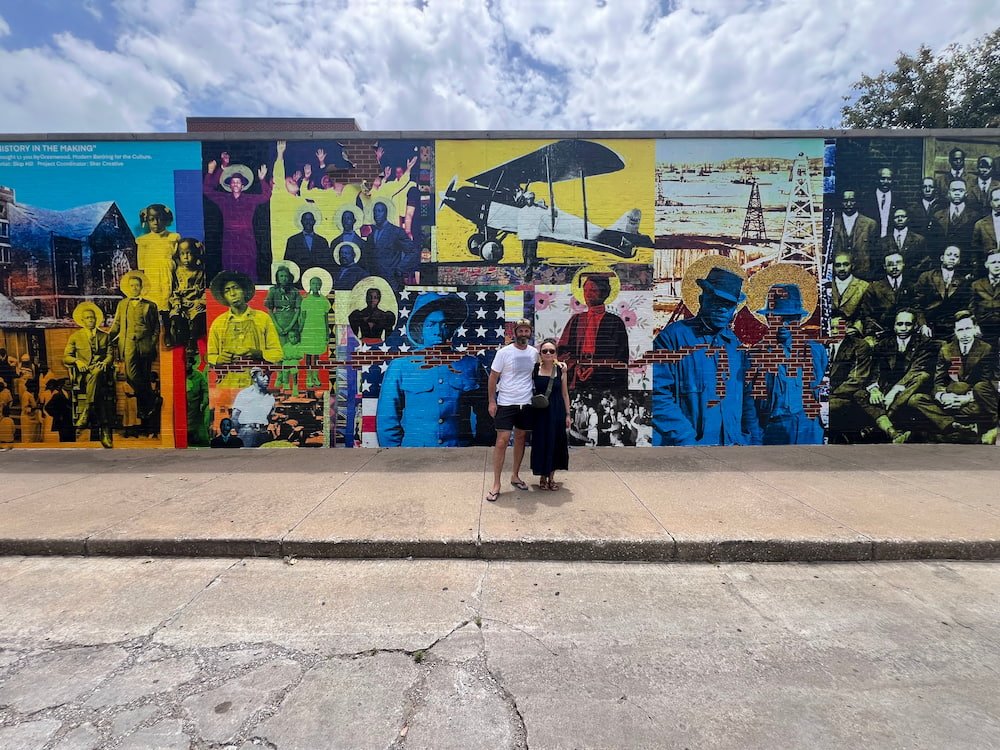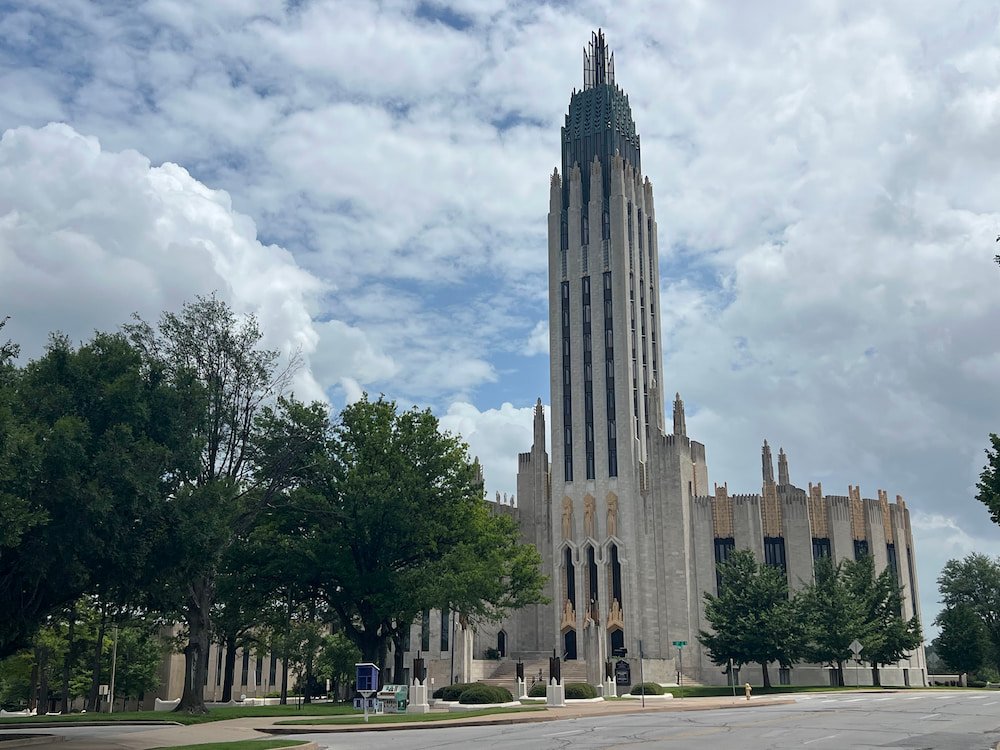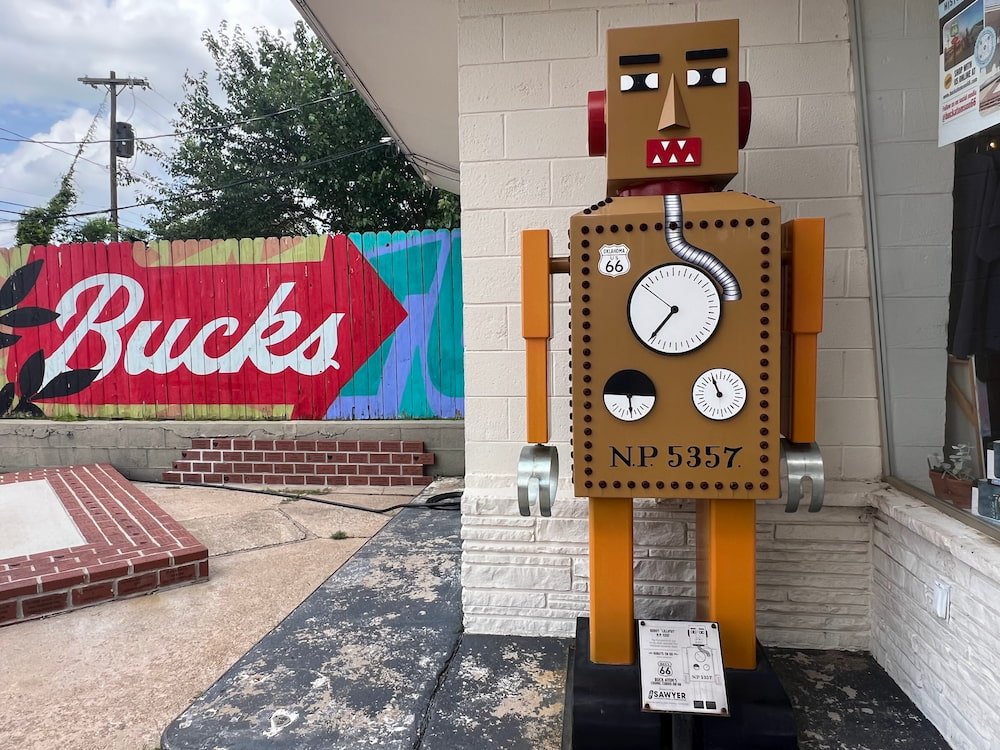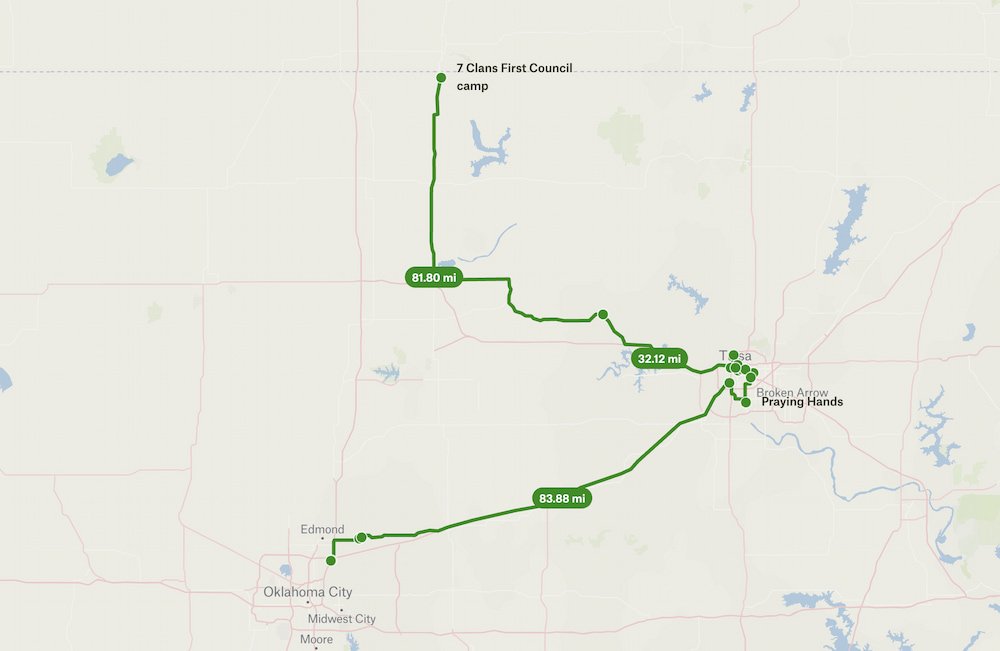Driving further into Oklahoma the next morning, we saw all these store chain names that we'd never heard of before: Ollie's (a discount store), Heartland Grocery and Pharmacy, Golden Chick (a fried chicken franchise), and Willy's Wash (ok, this was real but seemed to only be one store in Oklahoma--still, that store name would be the butt of all jokes in Australia)!

As we arrived in the city of Tulsa, our first stop was the Cave House, opened in 1926 as a chicken restaurant/speakeasy. At night, customers would go down a secret tunnel through the fireplace that went to a big room under the hill. There are tours that the current owner runs to see the house and hear all the stories about its history. The House is definitely distinctive, and was decorated with American flags all around it for Independence Day yesterday.
Tulsa Aviators Arrow
We'd been disappointed by the Amelia Earhart Earthwork in Kansas as her portrait on the grass was overgrown, so we hoped to be able to better see the Tulsa Aviator's Arrow, which has the letters measuring over 15 meters (50 feet) in height. They're spelled out with crushed white marble, with an arrow pointing underneath, and was used to guide aviators including Charles Lindbergh.

While we were happily able to see the word and arrow clearly without needing to be up high, as soon as we got out of the RV we felt the extreme beating heat--it was burning! The heat has been constant over the summer so far. Fortunately, it was a quick photo op stop, and easy to find parking (it's across the road from a residential area).
Black Wall Street
The Greenwood District in Tulsa is known as "Black Wall Street", as from the 1900s until 1921 it was one of the most preeminent and wealthiest Black community in the nation, with many Black-owned businesses thriving in the area. However, May 31 and June 1, 1921, was one of the darkest and most horrific times in US history, with mobs of white residents and white supremacists attacking and killing Black residents, destroying homes, burning down businesses. It's one of the worst incidents of racial violence in American history, but was largely omitted from local, state, and national histories for years. Many survivors left Tulsa, while residents who chose to stay in the city, regardless of race, largely kept silent about what happened.






Sometimes, you visit a place that's had a horrific history and the place feels heavy, weighed down with its past. There's a clear recognition now of what occurred in Greenwood, with lots of murals a museum (Greenwood Rising Black Wall St. History Center), and even stores selling Black Wall Street t-shirts and other merchandise. However, we found the district to also be alive and friendly, with a lively outdoor market, folks sitting outside eating food from the local Soul Food restaurant, and folks greeting us with a "Hey, how you doing?" on several occasions. We took some photos and a man walked over asking if we'd want him to take our photo in front of the mural too! It's not a big district, but it was heartwarming to see so many Black businesses open and flourishing when we were there.
Downtown Tulsa
Tulsa has a lot of Art Deco architecture, a legacy of its oil boom period in the 1920s. We attempted to see the Denver Ave Station first, but the environment around it was not great--lots of sketchy looking people out and about, that we aborted our walk and skipped this one.


We drove instead to see "The Majestic", the world's largest augmented reality mural. It's a really fun mural, best viewed across the street. On the ground, there's a QR code that leads to the AR experience, so that when we hovered our phone over the mural, it would show it coming to life!

While we missed the first Art Deco stop, we got to see this architecture at the Boston Ave United Methodist Church, which is considered to be one of the finest examples of ecclesiastical Art Deco architecture in the United States. It's a massive building, so we struggled a bit to fit it all into one shot!
Back to Route 66
Tulsa also cuts through parts of Route 66, one of the most famous and iconic highways in the US. We hadn't been through Route 66 for months now (not since Arizona, or was it Albuquerque in New Mexico)?, but we loved seeing the old-school the retro signs, murals, statues and shops again. We checked out the Meadow Gold District, walking up this stretch of road to see the statue of Buck Atom, standing outside a gift shop that was a former gas station, and many others.







While we'd already had lunch in the RV, we'd also read positive reviews about Mother Road Market, a food hall with cuisines from around the world, including West African, Mexican, Japanese, and others. Because of how hot it was, we ended up getting some internationally inspired rice bowls from Bodhi's Bowl, which we had for dinner (healthy, filling, and yum), as well as a milkshake from Big Dipper Creamery. If we had been in Tulsa for longer, we would have wanted to try other cuisines here.


More Huge Statues: Golden Driller and Praying Hands
Near Route 66, at the Tulsa Expo Center, is the Golden Driller Statue, currently the 7th-largest statue in the US, weighing in at a whopping 43,500 pounds and measuring 23 meters (76 feet) tall. It was first unveiled at the 1953 International Petroleum Exposition as a temporary feature, but because of its popularity it's now a permanent fixture, and has been adopted as a state monument.


The World's Largest Praying Hands are made out of bronze, and are at the entrance of Oral Roberts University. Perhaps just as fascinating as the hands is the university itself, which had a number of massive, golden glistening buildings on campus. We don't know much about Oral Roberts, other than he was an American Christian televangelist, and one of his sons is also a televangelist. The university was founded in 1963 as a private evangelical university, with thousands of students attending each year (in writing this, we looked up their Wikipedia entry and chuckled to see that Ned Flanders from The Simpsons is a notable alumni). Across the road from the university is their huge evangelical church, that looks like a stadium.

Returning to Route 66: Barn and Sodas!
We snaked our way back to Route 66 to pass the Route 66 Historical Village, which has a museum inside. While we got there too late in the day, there's a huge steam engine outside that used to travel from St Louis to San Francisco. As it was getting late in the day, we also stopped outside only to check out the Arcadia Round Barn, a striking red barn that's more than a century old, with a grey domed roof.



Fortunately, Pops 66 Soda Ranch was open, as we were wanting to go inside this building. Set in a gas station (although filling up on petrol is noticeably more expensive here), is a store that is stacked from floor to ceiling with glass soda bottles whose flavors make up the colors of the rainbow. Outside, there's a big monument of a soda bottle with a straw, and it lights up at night.





Going into Pops 66 Soda Ranch, the main attraction is definitely the sodas, although it also serves food, snacks, and souvenirs. We found soda flavors that we'd never seen before, and some we definitely did not want to try, including dill pickle, mustard, bacon, and even "barf" flavor?!! Michael wanted to try the red cream soda, a throwback to our childhoods in Australia when creaming soda was really popular. He ended up buying two different brands, and one of them (Dad's--funny since the store is called Pops), was more similar to the ones we had as kids, although both tasted pretty good (the other one was called Dang! Funny names).
Cracker Barrel
While we kind of wanted to stick around at Pops 66 Soda Ranch to see the bottle sculpture light up with LED lights, we didn't want to have to take the eBikes inside and drive in the dark, so we headed over to where there were other gas stations and truck stops for the evening. A couple of the truck stops were already jam packed, so we ended up parking at Cracker Barrel, a chain of restaurants. They're actually really popular for overnight parking, but we've not stayed at one until now! No issues with sleeping, unless you count dealing with yet another hot, humid night.
Route Map

